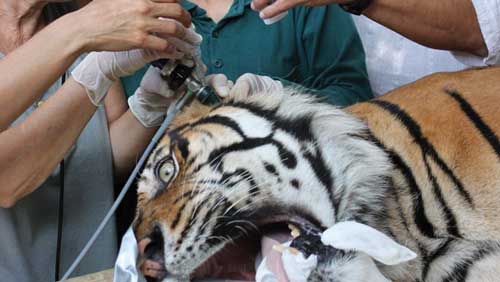.jpg)
The baby hedgehog, his eyes still closed but his spikes already fully out, arrived with a personal letter. “We found him near our house,” it said. “He was under some stairs, surrounded by our cats and dogs. We don’t know where his mother is. He didn’t eat for a whole day! Please take care of him and we would be happy to return him to nature.”
Ariela Rosenzwig, the Israeli veterinarian who read the letter out loud recently in the Wildlife Hospital in Ramat Gan, picked up the tiny creature. She carefully examined it and put it in her shirt pocket, for warmth. “His leg is broken,” she said, “but that’s the least of his problems. He should be in a cave with his mother; his chances of survival are low.”
Around Rosenzwig, various animals that were brought in to the only wildlife hospital in Israel were waiting their turn, all of them in cardboard boxes. There was a young falcon with wing problems and a jackdaw chick which was screaming his lungs out. On the operating table was a Steppe Eagle, which had been shot by an arrow somewhere in Africa, flew all the way to Israel and somehow found its way to the hospital, and had the arrow successfully removed from its flesh. An owl was awaiting a clean-up, and a small seagull was also in line for some treatment.
The hospital treats around 2,000 animals annually, and one day earlier this year had around 170 of them in hospitalization. “If it’s wild we accept it. Doesn’t matter if it’s a snake or a weasel, a deer or a hyena,” said Ronni, who manages the day-to-day operations in the hospital.Even crows and pigeons are taken care of, in keeping with the ethos of the hospital—saving animals.
“Our main aim is to return wild animals to nature, to preserve species, especially in a sensitive area like Israel,” Ronni added. “The majority of animals we receive and help are here because of human activity—getting hit by cars, electrocuted, tangled in traps.”
In the hospitalization ward there’s a range of Israeli wildlife, often sharing cages. “We are on a big migratory route here in Israel, so we have many birds in our care,” said Nilly, another veterinarian. Volunteers were feeding worms to dozens of chicks, all crying for attention. “I think she is missing some B12,” said Tina, a volunteer from Germany, massaging and feeding a young swift.
The hospital is equipped with X-ray machines, operating rooms and supplies for most kinds of animals. It is funded by public donations, private foundations and the Ramat Gan safari zoo in whose premises it is located. Four veterinarians are employed, receiving large animals almost every day from nature protection personnel and smaller ones from caring citizens, as in the case of the baby hedgehog.
“I want to X-ray him,” said Ariela after warming up the creature. She did so twice, to be sure of the right diagnosis.
He was not doing well. “See these gasps? If we don’t do something, he will die.”
She inserted an IV directly into his leg bone. “This is life and death now,” she said. “Poor guy.”
“You get attached to all animals,” said Nilly, who has worked in the hospital for eight years.
One of those was a hyena that was hit by a car and was now recovering following surgery. “He was standing today,” Ronni updated Nilly with a smile. “It’s a promising start.”
Sometime they name the animals, Nilly said, especially the big ones that stay a while.
The hospital treats some of the safari’s more complex cases—not so wild, but still in need of medical care. Pedang the tiger, for example, who is 14 years old and suffers from chronic ear infections, was treated by Rosenzweig and other veterinarians this spring, under full anesthesia. He also received a lengthy acupuncture session. “This is usually done on much smaller animals,” said the Safari spokesperson, Sagit Horowitz.
The hospital is staffed with the help of dozens of volunteers and young Israelis who choose to spend their army service there—and often stay afterwards, as Ronni did. “This place is addictive,” she said, as she watched the hedgehog intently.
In early afternoon, a group from the hospital marched out into the grounds of the safari to release one of the many swifts. “I need to see if it looks up to the sky when we’re out,” said Tina. It did. She opened her cupped hands, and the bird rose up.
“I don’t like the look of those crows,” said one of the volunteers, pointing to an ominous couple flying overhead.
But the swift “is the second-fastest bird in the world,” said Tina, as the newly released bird started to maneuver close to the ground, too rapidly for the crows.
That was the day’s balance: one swift released, and the baby hedgehog that didn’t make it. Inside the hospital, though, numerous other creatures were gradually, being nursed back to health, readied for a return to nature.
By Assaf Uni, The Times of Israel










